| Article ID | Journal | Published Year | Pages | File Type |
|---|---|---|---|---|
| 242302 | Advanced Engineering Informatics | 2011 | 14 Pages |
Actors involved in the computer-supported design process work together towards a common goal – the design of a building. Current collaboration approaches often focus on versioned and distributed building models, which describe virtual building states on the basis of the object-oriented method. State changes (for example moving a wall or modifying its material) remain unconsidered and lead to inconsistency problems when exchanging, comparing and merging versioned building models. This paper presents a new modeling approach that combines existing state-oriented descriptions of a virtual building with additional change-oriented information by means of design steps denoted as modeling operations. A new language is defined for the formal description of modeling operations. These operations establish a standardized processing interface for existing building models, can represent design intents, enhance current models with change semantics and add to the consistency of these models. Moreover, this paper presents new concepts for intra-domain collaboration and model management that overcome current limitations when exchanging, comparing and merging versioned building models. The pilot implementation and some project scenarios in industry verify that current design processes can benefit in principle from combined state-oriented and change-oriented building information.
Graphical abstractFigure optionsDownload full-size imageDownload as PowerPoint slideResearch highlights► Change-oriented building information can capture design intents. ► Information loss does not accumulate due to model change interpretation. ► Model comparison and merge procedures benefit from change-oriented building information. ► Employing model changes adds to the consistency of object-oriented building models.
